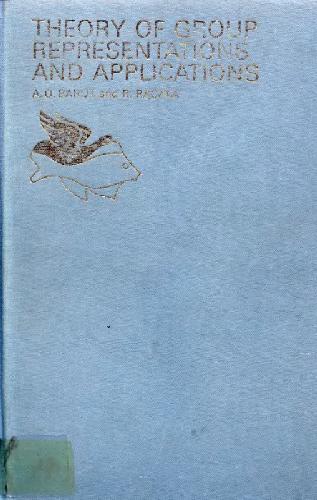Michael J. Field9781860948282, 1-86094-828-6
Table of contents :
Contents……Page 12
Preface……Page 6
1.1 Definition of a group and examples……Page 16
1.2 Homomorphisms, subgroups and quotient groups……Page 18
1.2.1 Generators and relations for .nite groups……Page 20
1.3 Constructions……Page 21
1.4 Topological groups……Page 23
1.5 Lie groups……Page 25
1.5.1 The Lie bracket of vector fields……Page 28
1.5.2 The Lie algebra of G……Page 29
1.5.3 The exponential map of g……Page 30
1.5.4 Additional properties of brackets and exp……Page 33
1.5.5 Closed subgroups of a Lie group……Page 35
1.6 Haarmeasure……Page 36
2.2 Groups and G-spaces……Page 38
2.2.1 Continuous actions and G-spaces……Page 39
2.3 Orbit spaces and actions……Page 40
2.4 Twisted products……Page 45
2.4.1 Induced G-spaces……Page 46
2.5 Isotropy type and stratification by isotropy type……Page 48
2.6 Representations……Page 51
2.6.1 Averaging over G……Page 53
2.7 Irreducible representations and the isotypic decomposition……Page 55
2.7.1 C-representations……Page 58
2.7.2 Absolutely irreducible representations……Page 59
2.8 Orbit structure for representations……Page 62
2.9.1 Slices for linear finite group actions……Page 64
2.10 Invariant and equivariant maps……Page 66
2.10.1 Smooth invariant and equivariant maps on representations……Page 68
2.10.2 Equivariant vector fields and flows……Page 70
3.1 Proper G-manifolds……Page 72
3.1.1 Proper free actions……Page 75
3.2 G-vector bundles……Page 78
3.3 Infinitesimal theory……Page 80
3.4.1 Exponential map of a complete Riemannian manifold……Page 81
3.4.2 The tubular neighbourhood theorem……Page 82
3.4.3 Riemannian G-manifolds……Page 84
3.5 The differentiable slice theorem……Page 86
3.6 Equivariant isotopy extension theorem……Page 88
3.7 Orbit structure for G-manifolds……Page 89
3.8 The stratification of M by normal isotropy type……Page 93
3.9 Stratified sets……Page 95
3.9.1 Transversality to a Whitney stratification……Page 97
3.9.2 Regularity of stratification by normal isotropy type……Page 98
3.10.1 The adjoint representations……Page 99
3.10.2 The exponential map……Page 100
3.10.3 Closed subgroups of a Lie group……Page 101
4.1 Introduction and preliminaries……Page 104
4.1.1 Normalized families……Page 105
4.2 Solution branches and the branching pattern……Page 106
4.2.1 Stability of branching patterns……Page 109
4.3 Symmetry breaking—theMISC……Page 110
4.3.2 Maximal isotropy subgroup conjecture……Page 111
4.4.1 Polynomial maps……Page 112
4.4.2 Finite determinacy……Page 114
4.5.1 The representations (Rk,Hk)……Page 115
4.5.2 Invariants and equivariants for Hk……Page 116
4.5.4 Bifurcation for cubic families……Page 118
4.5.5 Subgroups of Hk……Page 119
4.5.6 Some subgroups of the symmetric group……Page 121
4.5.7 A big family of counterexamples to the MISC……Page 122
4.5.8 Examples where P3G (Rk, Rk) = P3H k (Rk, Rk)……Page 123
4.5.10 An example with applications to phase transitions……Page 125
4.6.1 Cubic polynomial maps……Page 126
4.6.2 Phase vector field……Page 127
4.6.3 Normalized families……Page 128
4.6.4 Maps of hyperbolic type……Page 129
4.7.1 Preliminaries……Page 132
4.7.2 Polar blowing-up……Page 133
4.8 d(V,G)-determinacy, d(V,G) = 2,3……Page 135
4.8.1 d(V,G) = 2 but (V,G) is not 2-determined……Page 137
4.9 Counting branches and finding their location……Page 139
4.10 The symmetric and alternating groups……Page 140
4.10.2 Zeroes of the phase vector field……Page 141
4.10.4 The sign and index functions……Page 142
4.10.5 The case k + 1 odd……Page 143
4.10.6 The case k + 1 even……Page 144
4.11 The groups Sk+1 × Z2 and Ak+1 × Z2……Page 145
4.11.1 The zeros of PC……Page 146
4.11.2 Applications……Page 148
4.12 Appendix: Proof of theorem on hyperbolic elements……Page 149
4.13 Notes on Chapter 4……Page 151
5.1 The invariant sphere theorem……Page 152
5.1.1 Extensions and generalizations……Page 156
5.1.2 Applying the invariant sphere theorem……Page 158
5.2 The examples of dos Reis and Guckenheimer & Holmes……Page 159
5.3.2 Cubic equivariants……Page 165
5.3.3 Homoclinic cycles……Page 167
5.3.4 Stabilities and a ‘hidden Hopf bifurcation’……Page 176
5.4 Bifurcation to complex dynamics in dimension four……Page 177
5.4.1 A basis for the action of on C4……Page 178
5.4.3 Geometry of the representation (V,G)……Page 179
5.4.4 Equilibria of a normalized cubic family……Page 180
5.4.5 Dynamics close to the plane S……Page 183
5.4.6 Random switching and dynamics near a network……Page 187
5.4.7 Random switching theorem……Page 189
5.5 The converse to the MISC……Page 190
5.6 Hopf bifurcation and the invariant sphere theorem……Page 193
5.6.1 G × S1-equivariant families……Page 195
5.6.3 Projective space and the Hopf fibration……Page 198
5.6.4 Phase blowing-up……Page 199
5.6.6 Invariant sphere theorem for the Hopf bifurcation……Page 203
5.6.7 The algebraic Hopf theorem……Page 205
5.7 Notes on Chapter 5……Page 214
6.1 Introduction……Page 216
6.2 C∞-topologies on function spaces……Page 217
6.2.1 Jet bundles……Page 219
6.3.1 Basic theorems on transversality……Page 221
6.4 Stratumwise transversality and stability……Page 223
6.5 Reduction to a problem about solving equations……Page 225
6.6.1 Smooth equivariants……Page 227
6.6.2 Generators for equivariants……Page 228
6.6.3 Smooth invariant theory……Page 232
6.6.4 Smooth invariants and the orbit space……Page 233
6.7 The universal variety……Page 234
6.7.1 Changing generators……Page 236
6.8.1 Semialgebraic sets……Page 238
6.9 Canonical stratification of the universal variety……Page 240
6.9.1 Partition of Σ by isotropy type……Page 241
6.9.2 A first (restricted) de.nition of G-transversality……Page 242
6.10 Stratifying Στ and U……Page 244
6.11 Equivariant coordinate changes on V × Rs and W……Page 248
6.12 Symmetries of the stratification A……Page 250
6.13 Openness of equivariant transversality……Page 253
6.14.1 G-transversality on a manifold……Page 255
6.15 Solutions with specific isotropy type……Page 257
6.16 Notes on Chapter 6……Page 264
7.1.1 Generic 1-parameter steady-state bifurcation theory……Page 266
7.1.2 Bifurcation on absolutely irreducible representations……Page 269
7.1.4 Weak determinacy……Page 271
7.1.5 Weak stability of equivariant reversible vector fields……Page 273
7.2 Jet transversality……Page 275
7.2.1 An equivariant Thom jet transversality theorem……Page 276
7.2.2 Invariance lemmas……Page 280
7.3 Equivariant jet transversality for families……Page 282
7.3.1 Intrinsic formulation of jet transversality……Page 284
7.4 Stability and determinacy……Page 286
7.4.1 A reformulation of the stability criterion……Page 288
7.4.2 Example: computations for (R2,D4)……Page 290
7.5 Higher order versions of G-transversality……Page 292
7.6.1 Equilibrium G-orbits……Page 294
7.6.2 Branching and stability for compact Lie groups……Page 295
7.7 Notes on Chapter 7……Page 299
8. Equivariant Dynamics……Page 300
8.1.1 Vector fields and flows……Page 301
8.2.1 Diffeomorphisms……Page 302
8.2.3 Genericity……Page 303
8.2.4 Stable and unstable manifolds……Page 305
8.3 Relative fixed and periodic sets for diffeomorphisms……Page 306
8.3.1 Cartan subgroups of a compact Lie group G……Page 307
8.3.2 Dynamics on relative fixed & periodic sets……Page 310
8.3.3 Isotopy lemmas……Page 312
8.3.4 Stabilities of relative .xed sets and periodic orbits……Page 314
8.3.5 Perturbation theory……Page 317
8.4 Genericity theorems for equivariant diffeomorphisms……Page 319
8.5.1 Relative equilibria……Page 323
8.5.2 Stability of relative equilibria……Page 324
8.5.3 Classification of relative periodic orbits……Page 328
8.5.4 Periodic orbits and symmetry……Page 330
8.5.5 Poincar´e map for a relative periodic orbit……Page 331
8.5.6 Perturbation lemmas for relative periodic orbits……Page 333
8.6 Genericity theorems for equivariant vector fields……Page 335
8.7 Notes on Chapter 8……Page 337
9.1.1 Skew extensions of diffeomorphisms……Page 338
9.1.2 Principal G-extensions……Page 339
9.1.3 Skew products for flows and vector fields…….Page 340
9.2 Gradient dynamics……Page 341
9.2.1 Handlebundle decompositions of a G-manifold……Page 343
9.2.2 Triangulations and handlebundle decompositions……Page 345
9.3 G-subshifts of finite type……Page 348
9.3.1 Stability and the realization of G-subshifts of .nite type as basic sets of equivariant diffeomorphisms……Page 356
9.4 Suspensions……Page 358
9.5 The inverse limit: turning maps into homeomorphisms……Page 362
9.6 Solenoidal attractors……Page 366
9.6.1 Finite graphs……Page 368
9.6.2 Branched 1-manifolds……Page 370
9.6.3 Neighbourhoods of branched 1-manifolds……Page 371
9.6.4 Smooth graphs……Page 373
9.6.5 Group actions on graphs……Page 374
9.6.6 Twisted products and embeddings……Page 376
9.6.7 Smooth Eulerian paths……Page 378
9.6.8 Condition (W)……Page 379
9.6.9 Symmetric hyperbolic attractors — simply connected case……Page 382
9.6.10 Symmetric hyperbolic attractors — general case……Page 385
9.6.11 Examples in dimension 3……Page 387
9.6.12 Non-free finite group actions on attractors……Page 388
9.6.13 Symmetric hyperbolic attractors for flows……Page 390
9.6.14 A tubular neighbourhood of the embedded suspension……Page 392
9.6.15 Extensions to skew and twisted products……Page 393
9.7 Equivariant Anosov diffeomorphisms……Page 394
9.8 Notes on Chapter 9……Page 396
10.1.1 Complex representations and complex structures……Page 398
10.1.2 Normalized families on a complex representation……Page 401
10.1.3 Branches of relative equilibria……Page 402
10.1.4 The branching pattern and branching conditions……Page 404
10.1.5 Stability……Page 405
10.1.6 Determinacy……Page 406
10.2.1 The variety Σ……Page 407
10.3.1 Symmetry breaking isotropy types……Page 412
10.3.2 Weak determinacy……Page 413
10.4 Weak stability and determinacy for reversible systems……Page 415
10.4.1 The universal variety……Page 417
10.5 Stability and determinacy……Page 420
10.6.1 Reduction……Page 425
10.6.2 Steady state bifurcation……Page 426
10.6.3 Hopf bifurcation……Page 427
10.6.4 Additional results on drift dynamics……Page 428
10.7 Stability and determinacy for maps……Page 429
10.7.1 Branches of relative fixed points……Page 430
10.7.3 Geometric properties of Ξ,Ξ……Page 432
10.7.4 Stratification of……Page 435
10.7.5 Stability theorems……Page 436
10.7.6 Examples with G finite……Page 438
10.8 Strong determinacy……Page 441
10.9.1 Absolutely irreducible representations……Page 444
10.9.2 Irreducible unitary representations……Page 446
10.10 Relative periodic orbits……Page 448
10.10.1 G-vector bundles and maps over a group orbit……Page 450
10.10.2 Structure of LH(ρV , σV )……Page 453
10.10.3 The representation (V, (H,L ))…….Page 455
10.10.4 Normal form theory……Page 456
10.10.5 (V, (H,L) ) absolutely irreducible……Page 458
10.10.8 Representation theory……Page 459
10.10.9 Elementary irreducible representations of ( H, S )……Page 462
10.10.10 Central elements……Page 463
10.11 Notes for Chapter 10……Page 471
Bibliography……Page 472
Index of Notational Conventions……Page 482
Index……Page 486







Reviews
There are no reviews yet.